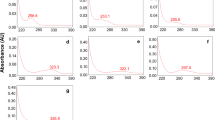Abstract
Phytopharmaceuticals are composed of many constituents and are therefore very capable of variation. The variability of the plant material is due to different growth, harvest, drying, and storage conditions. Therefore, cultivation of the plants under standardized conditions is desirable. The polarity of the solvent, the mode of extraction, and the instability of constituents may also influence the composition and quality of the extracts and must therefore be kept constant. The quality criteria for herbal drugs are based on a clear scientific definition of the raw material. Depending on the type of preparation, sensoric features, moisture, ash, physical constants, solvent residues, and adulterations have to be checked to prove identity and purity. Microbiological contamination and foreign materials, such as heavy metals, pesticide residues, aflatoxins, and radioactivity are further criteria to be tested.
To prove the constant composition of herbal preparations, adequate analytical methods have to be applied (eg, photometric analysis, thin layer chromatography [TLC], high performance liquid chromatography [HPLC], and gas chromatography [GC]). Depending upon whether the active principle of the plant is known or not, different concepts (“normalization” vs. “standardization”) have to be applied in order to establish relevant criteria for uniformity.
Similar content being viewed by others
References
Bauer R, Czygan F-C, Franz G, Ihrig M, Nahrstedt A, Sprecher E. Demands on the quality of rationally applicable phytopharmaceuticals (in German). Dtsch Apoth Ztg. 1993;133:4105–1108.
Bauer R, Czygan F-C, Franz G, Ihrig M, Nahrstedt A, Sprecher E. Pharmaceutical quality, standardization and normalization of phytopharmaceuticals (in German). Z Phytother. 1994;15:82–91.
Bauer R, Tittel G. Quality assessment of herbal preparations as a precondition of pharmacological and clinical studies. Phytomedicine. 1996;2:193–198.
WHO. Research guidelines for evaluating the safety and efficacy of herbal medicines. World Health Organization, Regional Office for the Western Pacific, Manila; 1993.
Gaedcke F. Phytopharmaceuticals—Definition and explanation of important terms used in the judgement of their manufacturing process and quality (in German). Dtsch Apoth Ztg. 1991;131:2551–2555.
Carle R, Fleischhauer I, Fehr D. Judgement of quality of chamomile oils (in German). Dtsch Apoth Ztg. 1987;127(47):2451–2457.
Massoud HY, Franz C. Quantitative genetical aspects of Chamomilla recutita (L.)Rauschert II. Genotype-environment interactions and proposed breeding methods. J Ess Oil Res. 1990;2:299–305.
Bauer R, Mayrbäurl I, Stuppner H. Comparative studies on the polar constituents of chamomile preparations (in German). Sci Pharm. 1981;59:2.
Schmidt, PC. Standardization (in German). Dtsch Apoth Ztg. 1997;137(5):315–322.
Hasler A, Meier B, Sticher O. Qualitative and quantitative high-performance liquid chromatographic determination of the flavonoids from Ginkgo biloba. J Chromatogr. 1992;605:41–48.
Schreiber A, Carle R, Reinhard E. On the accumulation of Apigenin in Chamomile flowers. Planta Medico. 1990;56:179–181.
Bauer R. Standardization of Echinacea purpurea expressed juice on cichoric acid and alkamides (in German). Z Phytother. 1997;18:270–276.
Uehleke B, Frank B, Reinhard E. Valuation and comparability of phytopharmaceuticals (in German). Dtsch Apoth Ztg. 1993;13:4105–4108.
Kooperation Phytopharmaka. Therapeutic equivalence (in German). Dtsch Apoth Ztg. 1995;135:321–322.
Gaedcke F. Pharmaceutical equivalence (in German). Z Phytother. 1996;17:221–234.
Meier B, Linnenbrink N. Status and comparability of herbal drugs (in German). Dtsch Apoth Ztg. 1996; 136:4205–4220.
Feiden K ed. Arzneimittelprüfrichtlinien. Stuttgart: Wissenschaftliche Verlagsgesellschaft; 1997.
Harnischfeger G, Flämig H, Halbach G, Kopanski L, Nufer H, Poppe G, Stumpf H. Suggestions for frame requirements for testing and standardization of herbal raw materials and extracts in the industrial field (in German). Pharm Ind. 1983;45:793–795.
Schilcher H. Rating of phytotherapy within alternative and school medicine (in German). Ärztezeitschrf Naturheilverf. 1996;37:23–34.
Harnischfeger G ed. Qualitätskontrolle von Phyto-pharmaka. Stuttgart, New York: Georg Thieme Verlag; 1985.
Hamacher H. Standardization of complex natural substances—official goals and their realization. Pharm-Unserer-Zeit. 1995;24(3): 130–136.
Meier B. Pharmaceutical plant extracts. Encyclopedia of Analytical Science. 1995;3882–3892.
Stumpf H, Spieß E, Habs M. Herbal drugs: Solvent residues (in German). Dtsch Apoth Ztg. 1992; 132(11):508–513.
Steinhoff B. Quality control of herbs and herbal preparations in consideration of new legal regulations (in German). Z Arznei- & Gewürzpfl. 1997; 2(1):10–14.
Schilcher H. Residues and impurities in herbs and herbal preparations (in German). Planta Medica. 1982;44:65–77.
EEC Notes for Guidance “Quality of Herbal Remedies” CD 75/318 EEC and CD 91/507 EEC.
Kunz K, Schaffler K, Biber A, Wauschkuhn CH. Bioavailability of ß-escin after oral application of two administrative forms of Aesculus extract to healthy volunteers (in German). Pharmazie. 1991; 46:145.
Schulz H-U, Schürer M, Krumbiegel G, Wächter W, Weyenmeyer R, Seidel G. Investigations on liberation and bioequivalence of Silymarin preparations (in German). Arzneim-Forsch/Drug Res. 1995; 45(1):61–64.
Author information
Authors and Affiliations
Rights and permissions
About this article
Cite this article
Bauer, R. Quality Criteria and Standardization of Phytopharmaceuticals: Can Acceptable Drug Standards Be Achieved?. Ther Innov Regul Sci 32, 101–110 (1998). https://doi.org/10.1177/009286159803200114
Published:
Issue Date:
DOI: https://doi.org/10.1177/009286159803200114




